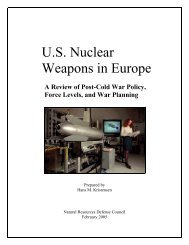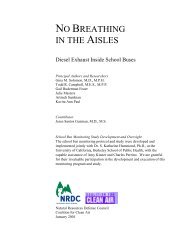p.53-94 (pdf) - Natural Resources Defense Council
p.53-94 (pdf) - Natural Resources Defense Council
p.53-94 (pdf) - Natural Resources Defense Council
Create successful ePaper yourself
Turn your PDF publications into a flip-book with our unique Google optimized e-Paper software.
Appendix C U.S. Nuclear Weapons, Location Profiles, CONTINUED<br />
NEVADA<br />
Rank: No. 4<br />
Nuclear Warheads: 1350<br />
Nellis<br />
AIR FORCE BASE<br />
NEVADA ranks 4th in number of nuclear warheads deployed, a<br />
significant rise from 14th in 1992 and 17th in 1985. Nellis AFB,<br />
north of Las Vegas, serves as one of two main Air Force nuclear<br />
weapons general depots in the United States (the other is at<br />
Kirtland AFB in New Mexico). Nuclear weapons are stored at the<br />
Nellis Area 2 (formerly Lake Mead Base) at a remote section of<br />
the Nellis complex. They are overseen by the 896th Munitions<br />
Squadron (formerly the 3096th Aviation Depot Squadron), a unit<br />
of the Air Force Materiel Command, though the nuclear facility is<br />
operated jointly for the AFMC and the Air Combat Command..<br />
It is estimated that 775 gravity bombs are in storage at Nellis,<br />
including 175 B61-7 and 600 B61-3/4/10 types. Most of these<br />
bombs have been withdrawn from retired B-52 bomber bases or<br />
from Europe. In addition, a portion of the surplus air-launched<br />
cruise missile warhead stock is estimated to be stationed at Nellis,<br />
made up of 575 W80 ALCMs.<br />
The nuclear weapons storage area (WSA) at Nellis was initially<br />
constructed by the AEC between 1953 and 1955 as one of 13<br />
original facilities built for storage, maintenance, and operational readiness of the nuclear stockpile.<br />
This storage area was originally separate from Nellis AFB and known as Lake Mead Base. Jointly<br />
operated by the AEC, the Armed Forces Special Weapons Project, and the U.S. Navy, the first weapons<br />
arrived at Lake Mead in 1955. The original complex included up to 10 storage buildings with<br />
vaults (“A” structures), a maintenance building (“C” structure), two other assembly/maintenance<br />
buildings, storage igloos, and a dry low-level radioactive waste disposal area. An emergency holding<br />
tank was connected the “C” structure. Area 2 became part of the main base in September 1969.<br />
Today, the 896th operates the largest U.S. above-ground munitions storage facility in the world.<br />
The 896th Squadron received the USAF Nuclear Surety Plaque for 1993 for “distinguished performance.”<br />
The Squadron and the sister 554th Security Police Squadron again received Nuclear<br />
Surety Plaques in 1995 for “outstanding achievements” and “contributions” to nuclear weapons safety.<br />
They had an NSI from February 9-22, 1997. The 896th is scheduled to receive its next NSI on July 27,<br />
1998. Air Combat Command conducted Nuclear Staff Assistance Visits (NSAVs) at Nellis in May<br />
19<strong>94</strong>, March 1995, and June 1996, focusing on nuclear bomb delivery training at the Air Warfare<br />
Center and certification of the 57th Wing’s F-15 and F-16 aircraft.<br />
62 TAKING STOCK
















